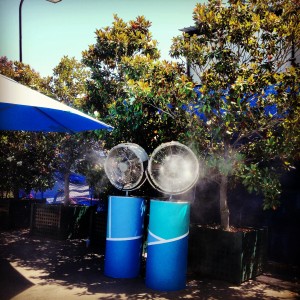 By Alexandra Willis in Melbourne
By Alexandra Willis in Melbourne
“Does Wimbledon have an extreme heat policy?”
It was a perfectly innocent question. But if you’ve ever been to Wimbledon, you will understand why it was an amusing one.
Rain delays, rather than heat delays, are a fact of SW19 life. The skies darken, the clouds let rip, the court coverers hurry on, the players grab rackets and bags and hurry off, and the umpire announces that play is suspended. You sit around gloomily clutching cups of tea. Lather, rinse, repeat.
And so, rather than an extreme heat policy, Wimbledon has a wet weather policy, which is largely (boringly but necessarily) about defining when the public are entitled to refunds.
The introduction of the Centre Court roof, when it is closed, when it is opened and why, has been the subject of as much debate as the heat policy here with regards to the logistics of when it is implemented, how it is measured and why. The Centre Court roof protocol is almost as obfuscating and vague as the Wet Bulb Globe Temperature. No governing body or committee or organisation is perfect.
But the reason for all these protocols is because of the need for a delay in play that is based on concerns for safety. The events of Wimbledon 2013 merely confirmed the perils of what can happen on wet grass, as players slipped and slid and injured themselves. Whatever the combination of reasons behind all of that was, it is very much acknowledged that if it’s raining, it is dangerous to play on grass.

So, if it starts to rain, at the discretion of the referee, play is stopped. The same is true at other tournaments. If it is raining, or thundering, or lightning, and the weather is considered dangerous, again, at the discretion of the referee, play is stopped.
Which begs the question, why should heat be any different?
As Andy Murray rightly said, these decisions are not easy to make.
“I think it’s tough. I think it’s tough for everybody. It’s tough for the referees, tournament director. It’s hard for the players. I mean, the medical staff. It’s very, very difficult,” Murray said.
“It’s very hard for the fans, the people watching. I mean, sitting there. Line judges, umpires. It’s not a good place to be in because, the heat is bearable just. It’s weighing out whether or not it’s kind of worth playing like that and it’s worth it for the fans and everyone.”
Whether the heat policy was activated early enough or not, the inconsistency is this. It states that once it has been enacted, at the discretion of the referee, any matches in progress will continue until the end of the set in progress before being suspended or the roof closed.
This might be ok on Rod Laver Arena and Hisense Arena, where at least there is some shade at each end of the court, although the extra 40 minutes that Maria Sharapova and Karin Knapp were subjected to were almost painful to watch. But on the outside courts, it is worse. There is nowhere to hide.
Which comes back to the same argument: if the conditions are dangerous enough for the policy to be put into effect, why not just stop?
The point has been made that players have been through this and far worse in years gone by, so why treat today’s players any differently, why change something that has worked for years?
“We evolved on the high plains of Africa chasing antelope for eight hours under these conditions,” Chief Medical Officer Tim Wood told the BBC.
But, with all due respect to players past (and those who chased antelope for eight hours), that was tennis of a different type. It has been said many times, by pundits, by press that today’s tennis, with technological advancements in rackets, balls, conditioning, is a different, more physical, more demanding beast.
And so, arguably, playing tennis in extreme conditions is more dangerous than it used to be, because the tennis is more extreme too.
“There will be some players who complain and no-one is saying it is terribly comfortable to play out there, but, from a medical perspective, we know that man is well adapted to exercising in the heat. Whether it is humane or not is a whole other issue,” Wood added.
No one thinks playing tennis should be easy. Any player would struggle to tell you the last time they felt ‘comfortable’ – they have niggles, pains, blisters, sores, aches, tweaks, tears… all around the world and back.
So the sport should be as safe as is manageable. That it should be humane should not even be up for discussion.
Follow @alex_willis on twitter
Visit the Sporting Intelligence home page for the latest news and exclusives






